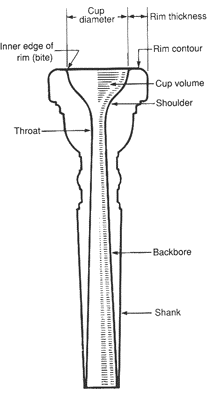Brass Advantage with Wayne Downey
Issue 2
Selecting The Mouthpiece That’s Best For You!!!
 Selecting a mouthpiece can be as mind-boggling as choosing a horn. The choices are endless and at times a bit confusing for a beginner as well as a professional. You’ll find mouthpieces made from all sorts of materials in all types of shapes, sizes, colors, cup styles, throat sizes, rim thicknesses, bore tapers and price ranges made by manufacturers all guaranteeing that their products are indeed "the best" in the world.
Selecting a mouthpiece can be as mind-boggling as choosing a horn. The choices are endless and at times a bit confusing for a beginner as well as a professional. You’ll find mouthpieces made from all sorts of materials in all types of shapes, sizes, colors, cup styles, throat sizes, rim thicknesses, bore tapers and price ranges made by manufacturers all guaranteeing that their products are indeed "the best" in the world.
To make things easier for you in selecting the right mouthpiece I think it’s important to first understand the components of a brass mouthpiece.
 Rim – The area of the mouthpiece your lips come in direct contact with. Rim thickness and contour are important factors to take into consideration while selecting a mouthpiece. Wider rims help with strength and endurance and provide most players with more of a comfortable feel than thin rimmed mouthpieces but at the same time restrict vibration and adversely affect articulation and flexibility due to the lack of surface area (tissue) vibrating. As a result, less of the musculature of the face/embouchure is working to produce your tone. Conversely, thin-rimmed mouthpieces provide clearer articulations and offer greater flexibility but create an edgier sound and are responsible for most of the thin red rings you see around a brass player’s faces using too much pressure. The recommendation I make to all my students is to avoid the wider/thicker rims unless they have a specific dento-facial need that requires them to and to find a mouthpiece that encourages vibration of more of the surface area (tissue) of the lips.
Rim – The area of the mouthpiece your lips come in direct contact with. Rim thickness and contour are important factors to take into consideration while selecting a mouthpiece. Wider rims help with strength and endurance and provide most players with more of a comfortable feel than thin rimmed mouthpieces but at the same time restrict vibration and adversely affect articulation and flexibility due to the lack of surface area (tissue) vibrating. As a result, less of the musculature of the face/embouchure is working to produce your tone. Conversely, thin-rimmed mouthpieces provide clearer articulations and offer greater flexibility but create an edgier sound and are responsible for most of the thin red rings you see around a brass player’s faces using too much pressure. The recommendation I make to all my students is to avoid the wider/thicker rims unless they have a specific dento-facial need that requires them to and to find a mouthpiece that encourages vibration of more of the surface area (tissue) of the lips.
You’ll also hear of rims being flat or "turned in" on the inner rim (bite) or having a high point in the contour. Flat rims (which are not really flat) will certainly hold the lips in place but will limit flexibility and vibration (much like a wider rim which usually tends to be on the flatter side.) Depending on the shape of the inner rim, which could be "turned in" drastically or rounded slowly, the feel of the mouthpiece could be very different. If the inner rim is "turned in" drastically it will feel as if it has an edge to it and will provide you with more flexibility while brightening your sound. If it slightly rounded it will feel much more comfortable, darken your sound and help with your endurance. As with any contoured shape there will be a "high point" in the contour. This high point helps determine the "feel" of the rim based on the location of the high point relative to the outer and inner edge of the rim.
While twisting your brain into knots about which of these options to choose, realize there’s one very important factor to keep in mind as far as I’m concerned, "Which rim style promotes the freedom and control of the vibration of the lips for YOU". Vibration = Tone, Tone = Vibration.
Cup – As with rim diameter the cup diameter also affects the color of sound you produce. A wider cup diameter will give you a darker or deeper sound whereas the smaller cup diameter will provide you with a brighter sound.
Cup shape and depth also affect the color of the tone you produce for example, the shallower the cup the brighter the sound, the deeper the cup the darker the sound. If the cup has a cone shape (also known as conical or "V" cup) it will produce a darker sound whereas in contrast a bowl shaped cup produces a brighter sound. Also understand that cup diameter also affects the volume of sound you produce as well. The larger the cup diameter the more surface area of the lip vibrates causing an increase in volume. The "V" cup allows you to send volumes of air through the mouthpiece without losing focus.
Throat – The size of the throat is another one of the factors in the mouthpiece’s design that determines the volume of sound you produce. I highly recommended that younger players start with smaller throat sizes and increase the size of the throat as their embouchures develop. The throat also channels the air, pitch and tone created in the cup to the backbore.
Backbore – The backbore of a mouthpiece controls both the resistance and tone of a mouthpiece. The tighter the backbore, the more brilliant the sound becomes with more resistance: the larger the backbore, the darker or warmer the sound becomes with less resistance. Occasionally a change in the backbore will improve the inherent faulty intonation of an instrument as well.
Shank – If your shank doesn’t fit snugly into the receiver of your instrument you’re really asking for trouble. The size of the shank determines how far the mouthpiece will travel into the receiver. If by chance the size of the shank is incorrect and the end of the mouthpiece doesn’t make contact with the end of the mouthpipe it will seriously affect resistance and intonation. The mouthpiece must butt up against the mouthpipe.
In selecting a brass mouthpiece one should consider tonal production and tuning first rather than range extension (which is the most common tendency in younger players) unless playing high is an absolute "must" in your daily performance responsibilities. Often the best possible mouthpiece choice is an intelligent compromise. Every teacher and player should strive for the optimum combination of the components listed above.
Other factors to consider in selecting the best mouthpiece include your teeth, jaw, shape of your lips (thickness and width), as well as the strength of your embouchure, the quality of sound that’s appropriate for the type of playing you do, extreme range demands (low as well as high), endurance and intonation. Your teacher may be more apt to help you with some of these decisions but definitely give each of them some thought before making your final decision…
As a good friend of mine by the name of Marty Erickson says, "Don’t expect a mouthpiece to fix all your woes. Practice, good teaching and proper technique are still the best tools…"
Well that’s about it for this month, don’t forget to send your questions or topics to: AskWayneDowney [at] drumcorpsplanet [dot] com.
When you get a chance log onto www.XtremeBrass.com to check out my "Signature Model" mouthpieces used exclusively by the Blue Devils as well as many nationally prominent marching bands and drum corps across the world. "Don’t Let The Chance Pass You By".
All My Best,
Wayne
Publisher’s Note:
Wayne Downey is the first of Drum Corps Planet’s panel of subject-matter expert columnists – providing our readers with expert information and insight from the best teachers and leaders in the drum and bugle corps activity. In addition to his long-term role as Music Director of the 11-time DCI World Champion Blue Devils drum and bugle corps – where he’s won 20 Jim Ott awards for "Excellence in Brass Performance", Wayne is distinguished as one of the finest brass teachers/clinicians and arrangers in the world. His work has been featured by some of the world’s most-respected drum corps, high school and collegiate bands – as well as the Tony and Emmy award winning show "Blast" and in feature films. In 1991 Wayne was inducted into the Drum Corps International Hall of Fame for his contributions to the Drum & Bugle Corps activity as the musical director for the Blue Devils. Wayne’s latest venture – XtremeBrass.com provides brass players of all ages and skill-levels, as well as educators, personalized lessons and access to his championship-winning techniques and methods. We’re honored to have him as one of our contributing columnists. -jmd
Wayne Downey was the first of Drum Corps Planet’s panel of subject-matter expert columnists – providing our readers with expert information and insight from the best teachers and leaders in the drum and bugle corps activity. In addition to his long-term role as Music Director of the 14-time DCI World Champion Blue Devils drum and bugle corps – where he’s won 21 Jim Ott awards for “Excellence in Brass Performance”, Wayne is distinguished as one of the finest brass teachers/clinicians and arrangers in the world. His work has been featured by some of the world’s most-respected drum corps, high school and collegiate bands – as well as the Tony and Emmy award winning show “Blast” and in feature films. In 1991 Wayne was inducted into the Drum Corps International Hall of Fame for his contributions to the Drum & Bugle Corps activity as the musical director for the Blue Devils. Wayne’s latest venture – XtremeBrass.com provides brass players of all ages and skill-levels, as well as educators, personalized lessons and access to his championship-winning techniques and methods.
Posted by Wayne Downey on Tuesday, May 2nd, 2006. Filed under Brass Advantage.
